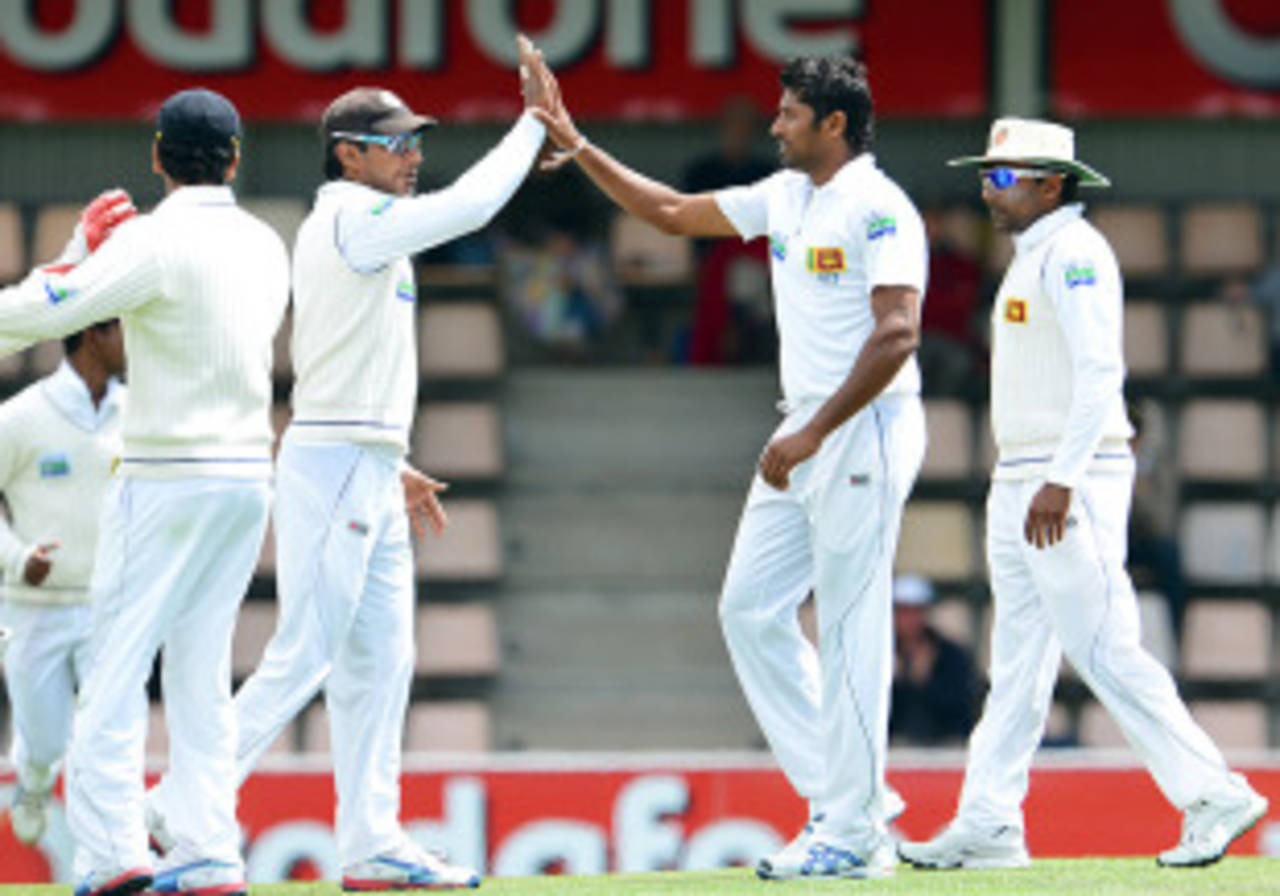When a back-of-a-length delivery from Mitchell Starc hit a crack in the Bellerive pitch and scooted through to the wicketkeeper at ankle height in the final hour on day four, Sri Lanka's hopes of a maiden Australian victory in
Hobart had all but sunk.
It had always seemed the least likely of the tour's three venues to deliver a triumph, but there had been a sniff of victory at tea. Sri Lanka's last fourth-innings total in Hobart had been 410, and they needed 17 fewer to take a series lead here, against an Australian attack depleted by injury. But as the shadows grew longer, the surface began to turn on the visitors. Survival will be preferred to offense on day five.
It is fitting that Sri Lanka's fate now largely rests with Nos. 3, 4 and 5. Tillakaratne Dilshan had showcased his enduring worth in the first innings, while the remainder of the vastly experienced top order had faltered. On day four, even Sri Lanka's bowlers proved more capable than many had suspected, knocking nine Australian wickets over in two sessions. Had a plumb lbw off Ed Cowan been awarded on day three, Australia would not have had as fine a platform upon which to aggress as their 132-run opening stand.
Still,
Rangana Herath collected his seventh five-wicket haul in nine Tests this year, and Chanaka Welegedara collected three wickets. If Sri Lanka's batsmen can achieve a defiant draw tomorrow, the visitors will move to Melbourne not only in high spirits, but with most parts of their machine humming nicely.
The consistency that features in Herath's 2012
harvest may not suggest he is a bowler who relies on confidence, but his first spell in a Test is almost uniformly reserved. Low trajectory and a rapid swish of the arm characterised his bowling in the first innings, and accordingly, he was economical but wicketless. At home, even the quicker ones can bite to win him a scalp, but Hobart's surface was not given to the same largesse, and Herath was made to wait for an errant cut from David Warner to add to his year's tally.
When the breakthrough came though, Herath unpacked his bag of tricks in earnest. The variations in pace became more acute, the ball hung in suspense a moment longer, and even the carrom ball appeared on occasion. Herath only has two right-hand batsmen in the Australian top six to take the ball away from, and Shane Watson, one of them, did poorly in his tussle with the spinner.
In the first four balls he faced from Herath, Watson survived two lbw shouts, and was stumped overbalancing on the fifth. Like Muttiah Muralitharan, Herath prefers to have men on the fence - even when he is bowling well - and today that hankering earned him a wicket, when Matthew Wade's belligerence came to rest in the hands of the long-on fielder.
"Five wickets is a good achievement because this is my first Test in Australia," Herath said. "Melbourne and Sydney, from what I've heard, will be more helpful to spinners. This is a good start for me in the series."
Many of the negative appraisals of Sri Lanka's attack before the tour had been founded on a cursory perusal of bowling averages, but
Chanaka Welegedara's stats do not do justice to his improvement in recent years. He was the worst of Sri Lanka's bowlers in the first innings, despite having the healthiest wicket tally, but his three wickets in the second dig were much better deserved.
Welegedara is working his way back from
injury and hitting 130 kph regularly, allowing his movement to pose a significant threat. Twice he found the leading edge of an aggressive Michael Clarke, only to see the ball sail over the infield and to the boundary in a resounding endorsement of Clarke's batmaker. He had already removed Ed Cowan, however, with one that came in off the seam, and Peter Siddle and Mitchell Starc were ill-equipped to counter Welegedara's reverse-swing with the old ball. Sri Lanka have regarded Welegedara as the leader of the pace attack, and he now seems to have found some of the rhythm that he lacked when he was left out during the recent series against New Zealand.
It is also encouraging for Sri Lanka that Mahela Jayawardene remains at the crease. In recent years he has been peerless on disintegrating pitches, and a dour but chanceless 37-ball stay on the fourth evening will steel him for the epic test to come on the fifth day. Australia are well aware of his mastery on such surfaces, having been Sri Lanka's opponents on a staggeringly dry Galle surface where Jayawardene was the only centurion.
Hobart's hazard stems from the cracks that have expanded with every ray of sunshine and every gust of wind on day four, while Galle's threat was more a result of a loose top layer of soil, but if Jayawardene succeeds in frustrating Australia on Tuesday, he will be largely following a blueprint he has already marked out. Kumar Sangakkara will be desperate to bust out of a poor run of form as well, and he need only look at his own fourth innings knock in Hobart five years ago for inspiration.
Only a near-miracle will see Sri Lanka score the 328 they need to win on a misbehaving pitch, but if at stumps on day five, they are not sitting on a series deficit, they will have learnt plenty and earned much for the matches that are ahead.
Andrew Fernando is ESPNcricinfo's Sri Lanka correspondent
